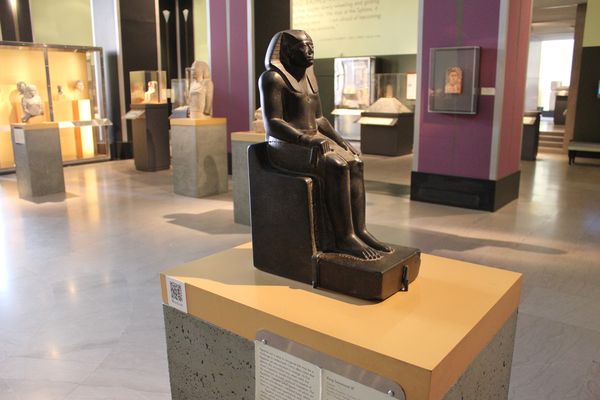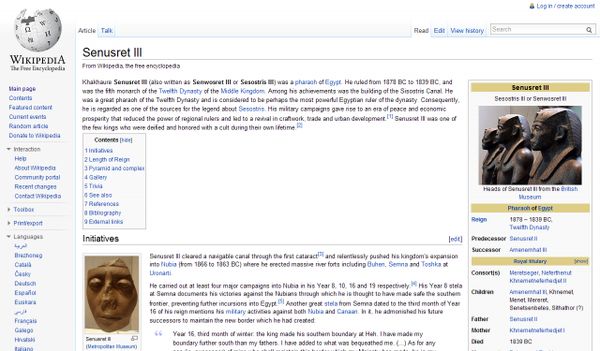Vetting Wikipedia for WikiLink
In Shelley’s previous post, she announced the installation of QR codes installed in exhibitions that lead visitors to Wikipedia articles for further information. These QR codes are now found in Egypt Reborn and the Hagop Kevorkian Gallery of Ancient Near Eastern Art, both on the third floor of the Museum.
As a curator I have always wanted our visitors to have access to more information about the collection than is usually available. I’ve long been frustrated that the 100-word label provides only the briefest introduction to an object. So when Shelley suggested that there was a way to bring in-depth information into the gallery for those who want it, I was happy to help find appropriate material. For example, the code on the label for the Museum’s statue of Senwosret III will take you to an article about the king’s reign. There you will find information on his building projects, his appointment of his son as co-regent—a sort of co-king-in-training—and his pyramid. All of this information is drawn from the latest scientific studies of the reign. The QR code with the faience shabti called “The Lady Sati” leads you to an article describing the process of making this material drawn from a basic Egyptology source—Paul T. Nicholson and Ian Shaw’s Ancient Egyptian Materials and Technology.

Senwosret III, on view in Egypt Reborn (now with QR code), was one of the most powerful kings of the Twelfth Dynasty.
All of the articles linked to the Museum’s objects have been vetted by curators. When we read an article, we could see from the footnotes whether or not it was based on standard interpretations by professional, scientific scholars. Ancient Egyptian art is the object of interest for both scientific scholars and a wide variety of other researchers using non-scientific means. The Museum adheres to scientific standards, so curators insured that all the linked articles are part of our interpretive tradition.

QR code in the gallery links to Senwosret III's Wikipedia page.
Wikipedia’s reputation with scholars and teachers is a mixed bag. Many teachers forbid its use because students are not always ready to read the articles found there critically. I was also wary about linking the Museum’s objects to a source that varies greatly in quality. But with proper vetting, Wikipedia offers additional background about the Museum’s objects based on the best information. I hope that this experiment with QR codes will help enhance the visitor’s experience in visiting the Egyptian and Ancient Near East collections.

Edward Bleiberg is Curator of Egyptian, Classical, and Ancient Middle Eastern Art at the Brooklyn Museum. He joined the museum in 1998 after 13 years teaching Egyptian hieroglyphs and directing the Institute of Egyptian Art and Archaeology at the University of Memphis. A native of Pittsburgh, he graduated from Mt. Lebanon High School and Haverford College. After graduate work at Yale University and the Hebrew University of Jerusalem, he earned an MA and Ph.D. in Egyptology at the University of Toronto. He is the author of books and articles on the ancient Egyptian economy, Egyptian coffins, and the Jewish minority in ancient Egypt and ancient Rome. Dr. Bleiberg has curated Jewish Life in Ancient Egypt, Tree of Paradise: Jewish Mosaics from the Roman Empire, and Pharaohs, Queens and Goddesses in Brooklyn. He is currently preparing To Live Forever: Egyptian Treasures from the Brooklyn Museum a traveling exhibition on Egyptian burial customs opening in June, 2008. He lives in Brooklyn with his wife and son.

Seb Chan - 12 years ago
Hi Edward
This is a fascinating experiment.
I’m drawn to this core notion –
I’d love you to expand a bit on the discussion around how this will work going forward given that these articles can and do often change. Did you have policies around the ‘stable-ness’ of an article that was being linked to? etc
I imagine that for some of the topics you have chosen the articles are going to be pretty static, however, if you were to scale this up to the museum as a whole, then other topics – for example relating to feminism or street art – might be far less stable, despite initially appearing to meet scholarly criteria.
Edward Bleiberg - 12 years ago
Dear Seb,
Your point about stability is well-taken.
Because Brooklyn Museum’s project is still experimental, we have not yet developed a strategy for tracking changes in Wikipedia articles. Right now we are only testing the usefulness of the QR code technology. By the end of the summer we hope to know if visitors are using the QR codes to obtain more information.
Yet we know, as you point out, if the whole museum were to be involved, it will be difficult to develop one-size-fits-all policies for all collecting areas of the museum. The Wikipedia emphasis on the “consensus view” makes it difficult to add “cutting-edge” interpretations. This might be a less difficult problem for Egyptology than it is, say, for femminist or contemporary art.
And stability would be an issue for us all. We will have to develop a reasonable method for tracking revisions to articles.
Once we think we have a method of accessing Wikipedia that visitors will use, we will continue to develop strategies to deal with these problems. Thanks for your comment.
Seb Chan - 12 years ago
Hi Edward
Thanks for the reply – I’ll keep an eye out for the results.
I do expect that visitors already access Wikipedia (and other sources) on their own devices when they can in the galleries in any case – and if they are using the museum’s own wifi you’d be able to know that.
I wonder if there may be less well-known and harder to find online resources on the same topics that you would have recommended over Wikipedia? (That visitors would have been unlikely to have been able to find on their own volition)
Or was the edit-ability of Wikipedia one of the key drawcards?
Shelley Bernstein - 12 years ago
Hi Seb,
We have discussed other sources, but there are issues (as you know) with those sources being properly formatted for mobile devices. Generally, with this project we are specifically looking to see if Wikipedia is what causes use to increase for QR. If it does, we continue with strategy. If it doesn’t, we question QR’s overall usefulness (given our current metrics) and the point of other resources becomes moot in this context.
Josh Butt - 12 years ago
Dear Edward and Shelley
I am currently writing an essay looking at the application of QR codes in museums and art galleries as part of my MA at Manchester University; I am also evaluating a local museum’s experimental use of QR codes in their temporary exhibition space.
During this evaluation I combined scan statistics with in-gallery observations. One of the most interesting findings was that the number of scans did not necessarily equate with the number of people benefiting from the content behind the QR code. In fact most people observed scanning a code were in a group, and content was viewed by more than one person.
Whilst only 2.6% of visitors (approx.) scanned a code, those benefiting from the scan exceeded this percentage.
What I suggest, is bearing in mind the social aspect of a scan when considering the success of a QR project.
Shelley Bernstein - 12 years ago
Good point, Josh, and thanks. Since we have a desk that’s being staffed in this exhibition, we’ll be able to see this behavior and, hopefully, account for it. Maybe not statistically, but we’ll get a general idea of what’s going on.